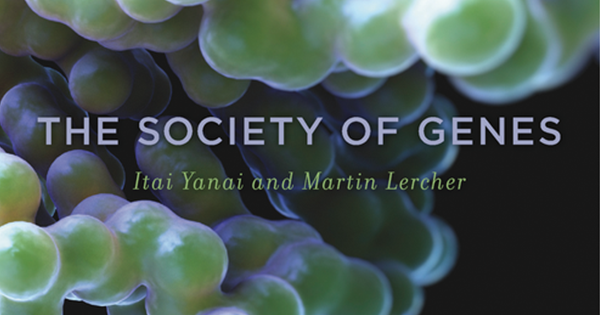The Society of Genes
Read an excerpt from Itai Yanai and Martin Lercher’s new book on evolutionary biology

The human genome has been fully sequenced, the microbial DNA in our bodies is the subject of a multimillion dollar NIH project, and seemingly every year another animal’s genome is added to the known world. But for all our knowledge of these molecules in isolation, no genes lives alone—and no gene survives alone. Instead, as Itai Yanai and Martin Lercher argue in their new book, The Society of Genes, these molecules are more like Adam Smith’s capitalists: groups of self-interested individuals competing and cooperating with one another to form a healthy marketplace—or in this case, an organism.
Individual genes may be selfish little buggers, as Richard Dawkins put it in 1976, but in order to survive through the ages, “genes had to cooperate in building and operating one survival machine after the other,” Yanai and Lercher write. When genes fail to cooperate, disastrous growth can mutate into cancer, or viruses can infect and destroy the organism. The stakes, then, for genes to cooperate as a society are pretty high. And as in any society, genes have to contend with the recruiting of new members, managing different responsibilities, and grappling with freeloaders. To understand just how individual genes work together, read an excerpt about how bacteria deal with viruses, the mother of all freeloaders.
Many bacterial genomes incorporate an odd-seeming structure, a region of about thirty DNA letters in a specific sequence, repeated up to one hundred times. These repeat regions account for as much as 1 percent of a bacterium’s genome and are nearly palindromic, meaning that they read almost the same forward and backward. These genomic repeats do not sit shoulder to shoulder but are separated by what the discoverers of these structures dismissively called “spacers.” Unlike the repeats, the spacer elements vary in length from twenty-five to forty letters long.
For many years, nobody knew what these repeat-spacer-repeat-spacer-repeat-spacer-repeat… segments were for. But the segments had to have a purpose, since bacteria tend to lose sequences they don’t need. Researchers gave the name CRISPRs to these segments for clustered regularly interspaced short palindromic repeats. The breakthrough in understanding the function of these anomalous regions came not from understanding what the conspicuous repeats are doing, but rather from a closer look at the seemingly useless spacers. The letter sequences of spacers were often found to be identical to parts of the letter sequences of known viral genomes. But why would a bacterial genome contain bits and pieces of viral information, carefully organized between repeats?
It turns out that these viral fragments are, in effect, mug shots of the bacterium’s past aggressors, posted inside each bacterial cell like photos of cheaters are displayed at casinos. The bacterium uses this information to recognize and eliminate intruders that resemble previous offenders, effectively immunizing itself from future attacks by close relatives of the viruses it has already encountered. This kind of bacterial immunity against viruses illustrates how a society of genes defines its borders: the bacterium maintains a database of what it is not, integrating a new mug shot into the genome whenever it detects a previously unknown enemy.
From The Society of Genes by Itai Yanai and Martin Lercher. Copyright © 2016 by Itai Yanai and Martin Lercher. Used by permission. All rights reserved.

